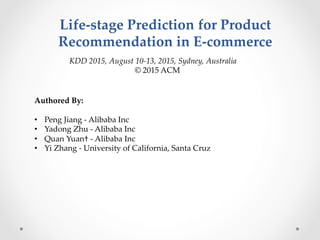
life-state-predications
- 1. Life-‐‑stage Prediction for Product Recommendation in E-‐‑commerce Authored By: • Peng Jiang -‐‑ Alibaba Inc • Yadong Zhu -‐‑ Alibaba Inc • Quan Yuan† -‐‑ Alibaba Inc • Yi Zhang -‐‑ University of California, Santa Cruz KDD 2015, August 10-‐‑13, 2015, Sydney, Australia © 2015 ACM
- 2. Overview • A model based recommender • Incorporates several ideas from ML and IR domains • Tries to model life-stage of consumers • Attempted on http://www.taobao.com
- 3. hKp://www.taobao.com/market/baobao/2014/ • Founded by Alibaba Group on 2003 • ~ 760 million product listings as of 2013 • One of the world’s top 10 most visited websites -‐‑ Alexa
- 4. Key contributions 1. Conception of life stages into E-commerce systems 2. A Maximum Entropy Semi Markov model for segmentation and prediction 3. An efficient large scale solution 4. A solution for modeling multi-kids scenario via Gaussian mixture models 5. Verification of the effectiveness in both offline and online scenarios
- 5. Core idea Importance of life stages on consumer’s purchasing behaviors • Bachelor stage • Newly married couples (young, no children) • Full nest (married couple with dependent children) • Empty nest (i.e. elder married couples with no children living together) o Head in labor force o Retired o Solitary survivors o Etc…
- 8. Markov models • Hidden semi-Markov model • Maximum-entropy Markov model Hidden semi-‐‑Markov model + Maximum-‐‑entropy Markov model = Maximum Entropy Semi Markov Model (MESMM)
- 9. Hidden Markov Models • Discrete and Continuous versions • Viterbi algorithm is used for most probable state sequence
- 10. Viterbi algorithm • A dynamic programming algorithm for finding the most likely sequence of hidden states Vt,k = The probability of the most probable state sequence responsible for the first t observations that have k as its final state ax,k = Transition probability from state x to k
- 11. Hidden semi-‐‑Markov model • The probability of there being a change in the hidden state depends on the amount of time that has elapsed since entry into the current state • This is in contrast to hidden Markov models.
- 12. Maximum-‐‑entropy Markov model • A sequence of observations - O1, …, On • Tag with the labels – S1,…,Sn • Such that - P(S1,…,Sn | O1, …, On) is maximized • Parameters λ can be learned using EM (Baum–Welch) • Optimal state sequence using Viterbi algorithm • Main advantage over HMMs: Overlapping/non-‐‑independent features
- 13. Maximum Entropy Semi Markov Model • The probability of life stage yt at time t depends on, o The previous life stage yt−1 at time t−1 o How long the user has been in the previous life stage o The observed user behavior sequence • Variable d changes deterministically o When life stage changes, d is reset to 0. Otherwise d decreases as time goes on
- 14. MESMM cont... Out Goal: Given an observed behavior sequence X, find the best underlying life-‐‑stage sequence y1,…,yk and the corresponding duration di,…,dk Xt: the observed behavior sequence at time t dt: the duration of a life stage at time t yt: the life stage label at time t lmin,lmax: The minimum and maximum lengths of life stage
- 15. Problem ? The inference process is computationally expensive! Have to predict both next state label and the duration of the period. But in Mom-‐‑baby domain… When you know the birthdate of the baby, transitions and durations become deterministic. Additionally, due to single-child policy in China, the default model assumes all families are single child.
- 16. Simplified model • A logistic regression model to predict yt based on the Xt. • Trains the model offline, using behavior sequences and birthdates provided.
- 17. Logistic regression classifier • Instead of items, categories are matched against user behavior sequences o Available items are changing frequently o Purchasing behaviors are more consistent at category level • Categories weighted using TFIDF to reduce the influence of popular categories
- 18. More on features… • User search queries o 3 years old children’s garments, large-size diaper …. o Lots of information o Pre-processed using Chinese word segmentation -> word vectors • Product labels and titles o Size – “M” or “L” o “Newborn”, “1-3 years” .etc • Temporal Effect of Features
- 19. Predicting • Probability of a user purchasing a product at a specific age a - P(p_productj , a) o p_productj - Probability of purchasing product J o a – Baby’s age • For users without age information: Estimate baby’s age distribution – Pu(a). Then do the same as above:
- 20. • With recent relaxations of one-child policy in China, there’s an increased number of multi-kids families (~10% from purchasing stats) • Uses a Gaussian mixture model • MLE/EM for parameter (w, sigma, mu) estimation • BIC/AIC for best K Multi-‐‑kids scenario aj,t = Purchasing age of the baby at time t C = The index of child K = Total number of children
- 22. Evaluation • ~8 million children birthdate information
- 23. Classification accuracy • With 5 fold cross-validation Basic -‐‑ logistic regression model with only product category features Prop – Product meta data Title – Segmented data from title Temp – Temporal effects Seg – Fixed baby life stage template is introduced to segment
- 24. Evaluating temporal effects • Temporal information play a very important role • Too small/too large window sizes are bad. 60 days is optimal • More number of windows (more history) is better
- 25. Online experiments (A/B testing) • 2 buckets – same mom-baby products • Bucket A – existing rec. system (CF, brand preference) • Bucket B – new system • Evaluating P(p_productj = yes)
- 26. Online experiments (A/B testing) uCTR = Click Trough Rate CVR = Click Conversion Rate
- 27. • Complex model and high computational cost • Not recommended as the first recommendation system • Fits very well for deterministic transition scenarios • Generalization is questionable… Summary
